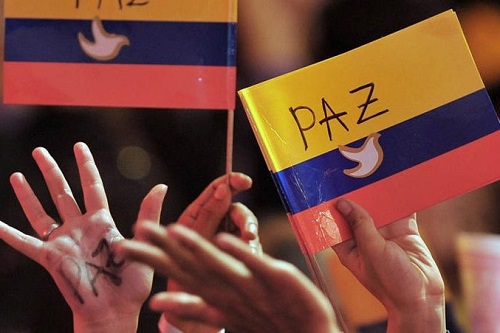AFP photo
By
Tom Arms
Tejo is the Colombian version of horse shoes. It is also a reflection of the national psyche. The target is packed with gunpowder. When it is hit, it explodes with a loud and violent bang.
The game was adapted by the Spanish from a gentler pre-Columbian version. Their conquest was cruel, violent and involved large quantities of gunpowder. Colombia has followed that route ever since. It is now trying to change. It will be difficult. It is not impossible.
Its history has been one civil war after another. In 1948 the murder of reforming presidential candidate Jorge Eliecer Gaitan sparked off the ten-year La Violencia.
The civil war that cost 200,000 lives also spawned the guerrilla organisation FARC. Its end in 1958 failed to address the country’s underlying social problems, leaving it ripe for a Castro-inspired guerrilla movement.
FARC needed money. So it developed the cocaine business and dabbled in extortion and kidnapping. An estimated 250,000 people died between 1958 and 2016. Five million were made homeless.
In 2002 Alvaro Uribe was elected president on a tough anti-FARC ticket. Uribe made good on his campaign pledges. President Manuel Santos won the Nobel Peace Prize, but inside Colombia, Uribe is credited with driving the guerrillas to the negotiating table. He is the most respected and popular politician in Colombia.
Which is why the country remains divided on the peace deal. Uribe opposes it. A key part of the peace deal is an amnesty for most of the FARC guerrillas. This is unacceptable to Uribe and he is determined to use next May’s presidential elections as a second referendum on the peace deal.
There are other problems, prominent among them is geography. Colombia’s topography ranges from towering peaks to dense rainforest and impassable swamps.
Almost everyone travels by plane. Colombia has fewer railways than Ghana and outside the urban areas the roads are winding, potholed efforts that leave the internal organs battered and bruised.
The result is a boon for the bad guys and a massive brake on economic development. The drug lords and guerrillas are able to melt into the jungles where they are almost impossible to locate. If they are found it is difficult to move enough security forces fast enough to effectively combat their operations.
The government has a $30 billion plus programme to overcome geographic obstacles. It plans port developments, 12,500 kilometres of roads, 1,600 kilometres of railways, 5,000 kilometres of maritime projects and 31 airport expansions.
Then there are the oligarchies. A dozen or so families own more than half the land and are unlikely to happily relinquish their control. Land reform is a key element in the deal with FARC. It was the oligarchs’ decision to push the peasants off the land in the name of efficiency that encouraged the establishment and growth of FARC.
Corruption and the drug trade continue to plague. Coca production is at record levels. A new generation of drug lords have filled the shoes of FARC and the late unlamented Pablo Escobar. They insure their operations by distributing funds to politicians.
Then there are the ELN guerrillas still hiding in the jungles. They are less than a quarter the size of FARC, but could become the nucleus for a revived guerrilla war if the government fails to deliver on its part of the peace deal.
To combat both the drug lords and the ELN the government has increased defence spending to $10.8 billion and sent another 80,000 troops into the jungles.
Colombia has the potential to succeed. It is rich in emeralds, gold, oil and gas. Its climate allows two harvests a year. Foreign investment is pouring into the country in the wake of the peace deal.
If Colombia can succeed then its example will become a beacon of hope for failed states around the world. But if the government puts a step wrong—the country could explode like a game of tejo.
Tom Arms is the editor of LookAheadnews.com. He has just returned from a three-week fact-finding mission to Colombia.
Sign up now for the weekly diary of world news events.
LookAhead Radio World Report for week commencing 18 September 2017:
Tom Arms
I am a journalist, entrepreneur and historian with extensive experience in print, web and broadcast journalism. I started as a diplomatic correspondent, wrote several books (The Falklands Crisis, World Elections On File and the Encyclopedia of the Cold War), and then in 1987 started my own business (Future Events News Service, www.fensinformation.com) which over 25 years established itself as the world and UK media’s diary. Our strapline was: “We set the world’s news agenda.” I sold FENS in December 2012 but retained the exclusive broadcast rights to all of FENS data. To exploit these rights I set up LookAhead TV which produces unique programmes which “Broadcasts Tomorrow Today” so that viewers can “Plan to Participate.” LookAhead has appeared regularly on Vox Africa, Radio Tatras International, The Conversation and Voice of Africa Radio.
In addition to being a syndicated broadcaster and columnist on global affairs, Tom is also available for speaking engagements and can be contacted on Twitter, Linkedin and email: [email protected].



No Comments Yet!
You can be first to comment this post!